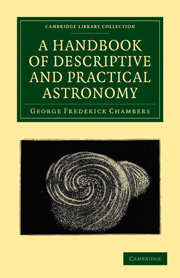Book contents
- Frontmatter
- PREFACE
- SUPPLEMENT
- Contents
- LIST OF ILLUSTRATIONS
- PRINCIPAL AUTHORITIES
- Errata
- A Handbook of Descriptive and Practical Astronomy
- BOOK I A SKETCH OF THE SOLAR SYSTEM
- BOOK II ECLIPSES AND THEIR ASSOCIATED PHENOMENA
- CHAPTER I GENERAL OUTLINES
- CHAPTER II ECLIPSES OF THE SUN
- CHAPTER III THE TOTAL ECLIPSE OF THE SUN OF JULY 28, 1851
- CHAPTER IV THE ANNULAR ECLIPSE OF THE SUN OF MARCH 14–15. 1858
- CHAPTER V THE TOTAL ECLIPSE OF THE SUN OF JULY 18, 1860
- CHAPTER VI HISTORICAL NOTICES
- CHAPTER VII ECLIPSES OF THE MOON
- CHAPTER VIII SUGGESTIONS FOR OBSERVING ANNULAR ECLIPSES OF THE SUN
- CHAPTER IX TRANSITS OF THE INFERIOR PLANETS
- BOOK III THE TIDES
- BOOK IV MISCELLANEOUS ASTRONOMICAL PHENOMENA
- BOOK V COMETS
- CHAPTER I GENERAL REMARKS
- CHAPTER II PERIODIC COMETS
- CHAPTER III REMARKABLE COMETS
- CHAPTER IV COMETARY STATISTICS
- CHAPTER V HISTORICAL NOTICES
- BOOK VI CHRONOLOGICAL ASTRONOMY
- BOOK VII THE STARRY HEAVENS
- BOOK VIII ASTRONOMICAL INSTRUMENTS
- BOOK IX A SKETCH OF THE HISTORY OF ASTRONOMY
- BOOK X METEORIC ASTRONOMY
- APPENDICES
- INDEX TO SUBJECTS
- INDEX TO NAMES
- Plate section
CHAPTER I - GENERAL REMARKS
Published online by Cambridge University Press: 05 July 2011
- Frontmatter
- PREFACE
- SUPPLEMENT
- Contents
- LIST OF ILLUSTRATIONS
- PRINCIPAL AUTHORITIES
- Errata
- A Handbook of Descriptive and Practical Astronomy
- BOOK I A SKETCH OF THE SOLAR SYSTEM
- BOOK II ECLIPSES AND THEIR ASSOCIATED PHENOMENA
- CHAPTER I GENERAL OUTLINES
- CHAPTER II ECLIPSES OF THE SUN
- CHAPTER III THE TOTAL ECLIPSE OF THE SUN OF JULY 28, 1851
- CHAPTER IV THE ANNULAR ECLIPSE OF THE SUN OF MARCH 14–15. 1858
- CHAPTER V THE TOTAL ECLIPSE OF THE SUN OF JULY 18, 1860
- CHAPTER VI HISTORICAL NOTICES
- CHAPTER VII ECLIPSES OF THE MOON
- CHAPTER VIII SUGGESTIONS FOR OBSERVING ANNULAR ECLIPSES OF THE SUN
- CHAPTER IX TRANSITS OF THE INFERIOR PLANETS
- BOOK III THE TIDES
- BOOK IV MISCELLANEOUS ASTRONOMICAL PHENOMENA
- BOOK V COMETS
- CHAPTER I GENERAL REMARKS
- CHAPTER II PERIODIC COMETS
- CHAPTER III REMARKABLE COMETS
- CHAPTER IV COMETARY STATISTICS
- CHAPTER V HISTORICAL NOTICES
- BOOK VI CHRONOLOGICAL ASTRONOMY
- BOOK VII THE STARRY HEAVENS
- BOOK VIII ASTRONOMICAL INSTRUMENTS
- BOOK IX A SKETCH OF THE HISTORY OF ASTRONOMY
- BOOK X METEORIC ASTRONOMY
- APPENDICES
- INDEX TO SUBJECTS
- INDEX TO NAMES
- Plate section
Summary
The class of bodies which will now come under our notice are among the most interesting with which the astronomer has to deal. Appearing suddenly in the nocturnal sky, and often dragging after them tails of immense size and brilliancy, they were well calculated, in the earlier ages of the world, to attract the attention of all, and still more to excite the fear of many. It is the unanimous testimony of history, during a period of upwards of zooo years, that comets were always considered to be peculiarly “ ominous of the wrath of heaven, and as harbingers of wars and famines, of the dethronement of monarchs, and the dissolution of empires.” We shall hereafter examine this question at greater length. Suffice it for us, here, to quote the words of the Poet, who speaks of
“The Hazing Star,
Threat'ning the world with famine, plague, and war;
To princes, death; to kingdoms, many curses;
To all estates, inevitable losses;
To herdsmen, rot; to ploughmen, hapless seasons;
To sailors, storms; to cities, civil treasons.”
However little attention might have been paid by the ancients to the more ordinary phenomena of nature (which, however, were pretty well looked after), yet certain it is, that comets and total eclipses of the Sun were not easily forgotten or lightly passed over; hence the aspect of remarkable comets that have appeared at various times have been handed down to us, often with circumstantial minuteness.
- Type
- Chapter
- Information
- A Handbook of Descriptive and Practical Astronomy , pp. 185 - 194Publisher: Cambridge University PressPrint publication year: 2010First published in: 1861

